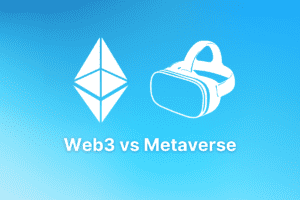How to Invest in Web3? (7 KEY Things You Need to Know!)
We’re reader-supported; we may earn a commission from links in this article.
The world of technology is evolving rapidly, and Web3 is emerging as the next frontier in the digital landscape.
If you’re an active investor interested in exploring new investment opportunities and being part of the decentralized future, understanding how to invest in Web3 is crucial.
Let’s delve into the fundamentals of Web3, discuss the potential it holds, and provide you with valuable insights on investing in this exciting space.
Read on for more!
1. Understanding Web3

With the advent of Web3, the internet is transforming into a decentralized network that empowers individuals to create content and removes intermediaries.
Web3 encompasses various technologies such as blockchain platforms, smart contracts, and decentralized applications (dApps).
By investing in Web3 companies, you can participate in this paradigm shift and potentially benefit from the disruptive innovations it brings.
But it all begins with understanding it well first! Let’s run through what web3 is first:
a. What is Web3?

Web3 refers to the next generation of the internet from web2, where individuals have greater control over their digital lives through decentralization.
Unlike Web2, which relies on centralized platforms and intermediaries, Web3 enables peer-to-peer interactions, secure transactions, and ownership asset management of digital assets. It aims to provide users with privacy, security, and autonomy in their online experiences.
b. Key Features of Web3
Web3 introduces several key features that differentiate it from its predecessor:
- Decentralization: Web3 operates on decentralized networks, reducing reliance on central authorities and enabling greater trust and transparency.
- Blockchain Technology: The underlying technology of Web3 is the blockchain, a distributed ledger that records transactions securely and immutably.
- Smart Contracts: These self-executing agreements have predefined rules, enabling trustless interactions and automated processes.
- Tokenization: Web3 enables the creation and exchange of digital tokens, representing ownership or access rights to various assets or services.
2. The Potential of Web3
Web3 has the potential to revolutionize various industries and reshape the way we interact with the digital world.
Here are some key aspects of Web3’s potential:
a. Disintermediation and Decentralization
Web3 aims to eliminate intermediaries and empower individuals by enabling direct peer-to-peer transactions.
This disintermediation can potentially disrupt industries such as finance, real estate, supply chain, and more. By removing middlemen and unnecessary fees, Web3 can increase efficiency and reduce costs.
b. Blockchain Technology and Smart Contracts
The use of blockchain technology and smart contracts in Web3 provides security, transparency, and immutability to traditional companies.
Blockchain ensures that transactions are recorded tamper-proof, while smart contracts enable automated and trustless interactions with big companies. These features have the potential to transform sectors like finance, logistics, and governance.
c. Tokenization and Digital Assets
Web3 allows for tokenizing various assets, including real estate, art, intellectual property, and more.
This tokenization enables fractional ownership, liquidity, and new investment opportunities. Non-fungible tokens (NFTs) have gained significant attention in the Web3 space, representing an asset class of unique digital assets and opening up possibilities in art, collectibles, and gaming.
3. Investing in Web3
Web3 investing is an exciting opportunity that requires careful consideration of asset selection, investment advice, and a deep understanding of the evolving landscape.
In the next part of this article, we will explore the key factors to consider when investing in Web3, providing you with valuable insights and tips to make informed investment decisions.
a. Research and Education
Before diving into Web3 investments, educating yourself about the technology, projects, and trends shaping this space is crucial.
To stay well-informed, follow reputable sources such as personal websites such as industry publications, blogs, and podcasts. (Like this blog!)
Additionally, join online communities, forums, and social media platforms dedicated to Web3 discussions. I find Reddit, Twitter, and Discord to be great platforms for web3-related discussion.
Attending conferences, webinars, and workshops on decentralized technologies can also provide valuable insights and networking opportunities.
By understanding the fundamentals of blockchain, decentralized finance (DeFi), and non-fungible tokens (NFTs), you can make informed investment decisions based on a solid foundation of knowledge.
b. Choosing the Right Projects
Investing in web3 is typically putting your money into web3 projects that you evaluate as profitable.
Choosing the right ones can be a daunting task in the vast landscape of Web3 projects and cryptocurrencies.
Thorough due diligence is essential to identify promising opportunities. Start by evaluating the credibility and experience of the project team. Assess their expertise, track record, and commitment to transparency.
It’s better if they have already doxxed themselves so that you know they can’t run with your money.
Review the project’s roadmap to understand its future plans and milestones. Whitepapers provide detailed information about the project’s technology, vision, and potential.
Take the time to read and comprehend these documents to make informed decisions.
Lastly, consider the level of community engagement surrounding the project. A strong and active community can be an indicator of potential success.
c. Diversification
Diversification is a crucial strategy in any investment portfolio, and Web3 is no exception.
By diversifying your investments, you spread your risk across different projects, asset classes, and sectors.
Allocate a percentage limit your funds to a mix of promising projects with varying risk profiles.
You’ll want to have a mix of blue chip cryptocurrencies, NFT projects that you think will start for the long term, and maybe even some meme coins that can achieve a moonshot pump in price.
This approach helps protect your portfolio from the inherent volatility of the Web3 market and ensures that you have exposure to potential winners in the crypto sectors of the space.
Consider investing in different types of cryptocurrencies, decentralized applications (dApps), and NFTs to create a well-rounded and more diversified portfolio.
Note that this isn’t financial advice, please do your own due diligence on the web3 projects that you invest in.
d. Risk Management
Web3 investments come with their fair share of risks.
A good web3 investment strategy is implementing effective risk management strategies to safeguard your capital.
Start by defining your risk tolerance—the volatility you can comfortably handle. This will help you determine the portion of your portfolio you’re willing to allocate to Web3 investments.
Implementing stop-loss orders can limit potential losses by automatically selling your assets if they reach a predetermined price.
Stay updated on regulatory developments, which can significantly impact the Web3 landscape.
You can adapt your investment strategy accordingly by being proactive and well-informed about market demand.
e. Only Invest What You Can Afford to Lose
While Web3 investments offer great potential, it is crucial to approach them with caution. Only invest funds that you can afford to lose.
Like any investment, there are no guarantees of returns, and market volatility can impact the value of your investments.
Setting aside money specifically for high-risk investments like Web3 ensures that your financial stability is not compromised.

5. Investment Strategies for Web3

When it comes to investing in Web3, various strategies can be employed based on your goals and risk appetite.
Here are some common approaches you need to consider:
a. Long-Term Investment
Taking advantage of a long-term investment approach, passive investing in Web3 involves identifying promising projects and holding onto your investments for an extended period.
This strategy aims to capture the potential long-term value appreciation of Web3 technologies and other digital assets.
If you are confident in the future of certain blue-chip tokens or coins, looking at a long-term horizon can be a good way to invest.
b. ICOs and Token Sales
Initial Coin Offerings (ICOs) and token sales provide investment opportunities in early-stage Web3 projects.
However, caution is advised for active investing as the ICO landscape is known for its volatility and potential scams.
Make sure that you thoroughly research projects, review whitepapers, and assess the credibility of the team before participating.
c. Yield Farming and Liquidity Mining
Yield farming and liquidity mining are popular decentralized finance (DeFi) ecosystem strategies.
By providing liquidity to decentralized financial instruments, crypto tokens, and platforms, investors can earn rewards through additional tokens or interest.
However, these strategies have higher risks, including smart contract vulnerabilities and impermanent loss.
d. Staking and Governance
Staking involves holding and “staking” your tokens to support the operations of a blockchain network.
In return, you earn rewards for participating in network consensus. Additionally, some Web3 projects allow token holders to participate in governance decisions by voting on proposals and shaping the future of the protocol.
Staking and governance can be rewarding for long-term investors who believe in the project’s vision and want to be actively involved and contribute to its development.
e. NFT Investments
Non-fungible tokens (NFTs) have gained significant attention in crypto mining in the Web3 space.
NFTs represent unique digital assets like artwork, music, virtual real estate, and more.
Investing in NFTs can involve purchasing and holding rare or collectible items, participating in NFT marketplaces, crypto lending platforms, or supporting artists and creators.
Certain strategies for investing in NFTs include flipping smaller NFT projects or holding blue chip NFTs for the long-term.
Make sure you do your due diligence before putting your money into these projects, as there are scams.
6. Tools and Platforms for Web3 Investing
To navigate the Web3 investment landscape effectively, you can utilize various tools and platforms:
a. Wallets and Exchanges
Web3 wallets are essential for securely storing and managing your digital assets.
The best web3 wallets, like MetaMask, Trust Wallet, and Ledger, allow you to interact with decentralized applications and participate in token sales or DeFi activities.
Exchanges like Coinbase, Binance, and Uniswap provide platforms for buying and trading cryptocurrencies.
Coinbase and Gemini are good on-ramp platforms for you to convert your fiat currency into cryptocurrency, allowing you to enter the web3 space.
b. Decentralized Finance (DeFi) Platforms
DeFi platforms offer various financial services, including lending, borrowing, yield farming, and decentralized exchanges.
Examples include Compound, Aave, and Uniswap.
These platforms enable you to earn interest on your assets as passive income, access loans without intermediaries, and participate in liquidity provision.
c. NFT Marketplaces
NFT marketplaces facilitate the buying, selling, and trading of non-fungible tokens. Popular platforms include OpenSea, Rarible, and SuperRare.
These marketplaces connect artists, collectors, and enthusiasts, allowing you to explore unique digital art creations and potentially invest in promising NFT projects.
d. Investment Tracking and Analytics Tools
Tracking your Web3 investments and staying informed about market trends is essential.
Platforms like CoinMarketCap, CoinGecko, Dune Analytics, and DappRadar provide real-time data, analytics, and insights into financial markets and the performance of cryptocurrencies, projects, and decentralized applications.
7. Challenges and Risks in Web3 Investing
While Web3 offers exciting opportunities, it’s important to be aware of the challenges and risks involved:
a. Volatility and Market Uncertainty
The cryptocurrency and Web3 markets are known for their high volatility. Prices can experience significant fluctuations within short periods.
Market and passive investor sentiment, regulatory developments, and technological advancements can all impact the market cap and the total value of your investments.
Be prepared for market swings and consider long-term goals rather than short-term price fluctuations.
b. Scams and Fraudulent Projects
As with any emerging industry, Web3 attracts scammers and fraudulent projects. Exercise caution and conduct thorough research before investing in any project.
Be wary of promises of guaranteed returns, unrealistic claims, or projects with limited information available. Stick to reputable projects and platforms to mitigate the risk of falling victim to scams.
c. Regulatory Concerns
The regulatory landscape surrounding Web3 and cryptocurrencies is still evolving. Different jurisdictions have varying regulations, and changes in laws can impact the crypto market here.
Stay updated on regulatory developments in your country and ensure compliance with any relevant regulations to avoid legal issues.
Conclusion
Investing in Web 3.0 presents unique opportunities to be part of the decentralized future and potentially benefit from disruptive technologies.
By understanding the fundamentals of web3, conducting thorough research, diversifying your investments, and staying informed, you can confidently navigate this evolving landscape.
Remember to assess risks, set clear investment strategies, and stay resilient during market fluctuations.
FAQs
What is the difference between Web3 and Web2?
Web3 represents the next generation of the internet, characterized by decentralization, peer-to-peer interactions, and user ownership of their own data.
Web2, on the other hand, refers to the current internet landscape dominated by centralized platforms and intermediaries.
Is investing in Web3 risky?
Investing in Web3 comes with inherent risks, including market volatility, regulatory uncertainties, and the potential for scams. It’s important to thoroughly research projects, diversify your investments, and only invest what you can afford to lose.
By doing your own research, staying informed, and adopting risk management strategies, you can navigate the risks associated with Web3 investments.
How can I start investing in Web3?
To start investing in Web3, you can follow these steps:
- Educate yourself: Learn about blockchain technology, decentralized finance (DeFi), NFTs, and other aspects of Web3 through reputable sources, forums, and communities.
- Obtain a Web3 wallet: Set up a secure Web3 wallet such as MetaMask or Trust Wallet to store your digital assets.
- Research Projects: Conduct thorough research on Web3 projects, including their teams, roadmaps, whitepapers, and community engagement.
- Choose Reputable Platforms: Select trusted exchanges and decentralized platforms to buy and trade cryptocurrencies or participate in token sales and DeFi activities.
- Diversify Your Investments: Spread your investments across different projects, sectors, and asset classes to mitigate risks.
- Stay Informed: Continuously monitor market trends, news, and regulatory developments to make informed investment decisions.
Are there any minimum investment requirements for Web3?
There are generally no strict minimum investment requirements for Web3. You can start with a small amount that you are comfortable investing.
However, it’s important to consider transaction fees, gas fees (in the case of Ethereum-based projects), and potential investment risks when deciding on the amount to invest.
What are the potential returns on Web3 investments?
The potential returns on Web3 investments can vary significantly. Some investors have achieved substantial gains by identifying early-stage projects that have experienced exponential growth.
However, it’s important to note that the market is highly volatile, and returns are not guaranteed. It’s advisable to set realistic expectations before making an investment decision and focus on long-term investment strategies rather than short-term price fluctuations.

Justin Chia
Justin is the author of Justjooz and is a data analyst and AI expert. He is also a Nanyang Technological University (NTU) alumni, majoring in Biological Sciences.
He regularly posts AI and analytics content on LinkedIn, and writes a weekly newsletter, The Juicer, on AI, analytics, tech, and personal development.
To unwind, Justin enjoys gaming and reading.


